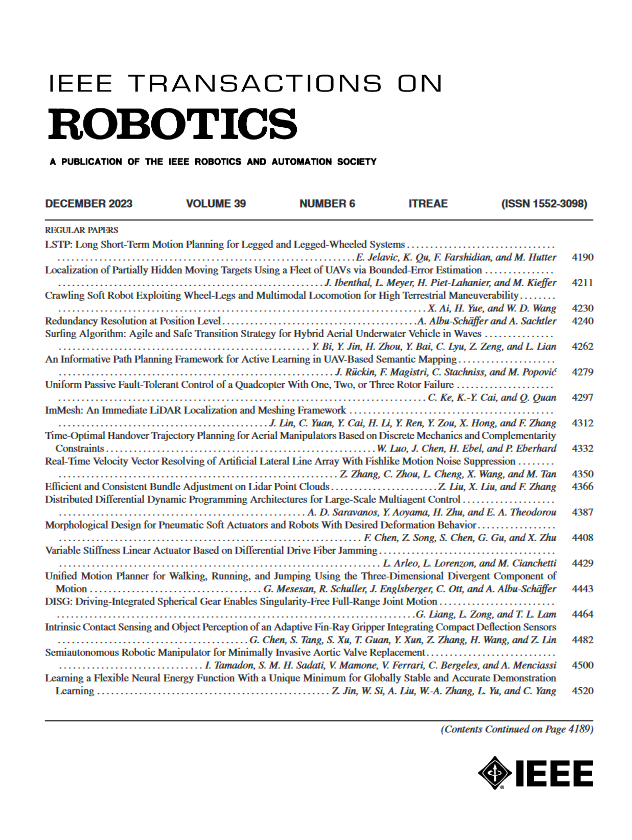基于lstm驱动的实时动态步态模式检测增强控制的足踝矫形器
IF 10.5
1区 计算机科学
Q1 ROBOTICS
引用次数: 0
摘要
实时步态模式检测的实现对于为使用驱动踝足矫形器(AAFOs)的个人提供量身定制的支持,增强他们的行走和机动性至关重要。然而,现有的系统通常依赖于多个传感器,并且难以准确和及时地检测步态转换,特别是在各种环境中。本研究开发了一种新型的实时步态模式检测系统,该系统仅使用两个足部惯性测量单元就能准确识别水平行走、斜坡上升和下降以及楼梯上升和下降等五种日常生活步态模式。一种基于长短期记忆的算法,对10个健康受试者的数据进行训练,提取6个运动学特征来预测步态模式。该方法将该检测系统与任务导向控制策略相结合,根据识别的步态模式适应AAFO控制。三名健康参与者的实时实验证明了稳健的步态模式检测,即使在辅助扭矩下,五种模式的平均准确率也达到了98 %。在模拟异常步态的试验中,该系统保持了93.3%的准确率。此外,对过渡延迟进行了分析,显示检测可以发生在前脚和后脚的过渡之间。控制策略减少背屈肌和跖屈肌的激活,通过肌电图测量,并改善摆动相跟踪性能。通过行走障碍和环境维度的变化进一步评估检测鲁棒性。本文章由计算机程序翻译,如有差异,请以英文原文为准。
Real-Time LSTM-Driven Dynamic Gait Mode Detection for Enhanced Control of Actuated Ankle-Foot Orthosis
The implementation of real-time gait mode detection is paramount for providing tailored support to individuals utilizing actuated ankle-foot orthoses (AAFOs), enhancing their walking and mobility. However, existing systems often rely on multiple sensors and struggle with accurate and prompt detection of gait transitions, especially in varied environments. This study develops a novel real-time gait mode detection system that accurately identifies five daily living gait modes including level walking, ramp ascent and descent, and stair ascent and descent using only two foot-mounted inertial measurement units. A long short-term memory based algorithm, trained on data from ten healthy subjects, extracts six kinematic features to predict gait modes. The proposed method integrates this detection system with a taskoriented control strategy to adapt AAFO control according to identified gait modes. Real-time experiments with three healthy participants demonstrated robust gait mode detection, achieving an average accuracy of $98 \pm 1$ $93 \pm 3$
求助全文
通过发布文献求助,成功后即可免费获取论文全文。
去求助
来源期刊

IEEE Transactions on Robotics
工程技术-机器人学
CiteScore
14.90
自引率
5.10%
发文量
259
审稿时长
6.0 months
期刊介绍:
The IEEE Transactions on Robotics (T-RO) is dedicated to publishing fundamental papers covering all facets of robotics, drawing on interdisciplinary approaches from computer science, control systems, electrical engineering, mathematics, mechanical engineering, and beyond. From industrial applications to service and personal assistants, surgical operations to space, underwater, and remote exploration, robots and intelligent machines play pivotal roles across various domains, including entertainment, safety, search and rescue, military applications, agriculture, and intelligent vehicles.
Special emphasis is placed on intelligent machines and systems designed for unstructured environments, where a significant portion of the environment remains unknown and beyond direct sensing or control.
 求助内容:
求助内容: 应助结果提醒方式:
应助结果提醒方式:


